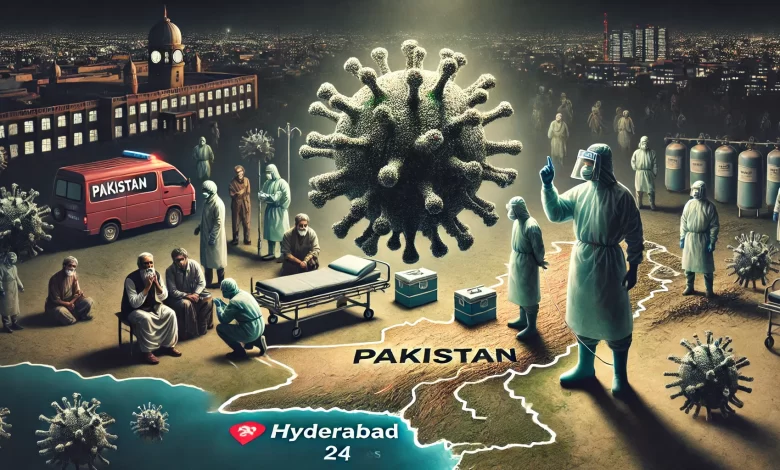
1. Introduction
Pakistan is grappling with a severe poliovirus outbreak, with the number of cases reaching a staggering 24 across the country. This alarming surge, including the latest case from Hyderabad, has raised both national and global concerns. Despite decades of efforts to eradicate poliovirus, Pakistan remains one of the few countries where this life-threatening virus still lingers. The current outbreak is a reminder of the persistent challenges the country faces in its fight against this crippling disease.
2. Understanding Poliovirus
Poliovirus is a highly contagious viral infection that primarily affects children under the age of five. It can cause paralysis in a matter of hours and, in some cases, can be fatal. The virus spreads through person-to-person contact, particularly in areas with poor sanitation. While there is no cure for poliovirus, it is preventable through vaccination. Pakistan has a long history with the poliovirus, struggling for decades to eliminate the virus from its borders, yet the battle is far from over.
3. Recent Poliovirus Outbreak in Pakistan
The year 2024 has seen a significant resurgence of poliovirus cases in Pakistan, with 24 confirmed cases so far. These cases have been spread across various regions, with some areas being more affected than others. The geographic distribution highlights vulnerabilities in both rural and urban settings, with major hotspots emerging in regions lacking adequate healthcare infrastructure. Factors such as vaccine hesitancy, political instability, and inadequate sanitation have all contributed to the recent outbreak.
4. The Hyderabad Case: A New Addition to the Crisis
Hyderabad, a major city in Pakistan’s Sindh province, recently reported a new poliovirus case, adding to the growing tally. This case has sparked concern due to Hyderabad’s dense population and the potential for the virus to spread rapidly. Local communities are alarmed, and health authorities are working swiftly to contain the situation. However, challenges such as lack of public awareness and limited resources have hampered the response.
5. National and International Concern
The rise in poliovirus cases has caught the attention of both national and international bodies. The World Health Organization (WHO) and UNICEF have been actively involved in supporting Pakistan’s efforts to curb the outbreak. On the national level, Pakistan’s government has ramped up its efforts, launching emergency vaccination campaigns in affected areas. Despite these efforts, the growing number of cases reflects the complexity of eradicating the virus, especially in regions with poor infrastructure.
6. Vaccination: A Critical Line of Defense
Vaccination remains the most effective tool in the fight against poliovirus. Pakistan has been running a large-scale vaccination campaign for years, but challenges such as vaccine misinformation and distrust in the healthcare system have slowed progress. In many areas, particularly in rural regions, vaccination coverage is still not high enough to create the necessary herd immunity to stop the virus from spreading.
7. Hygiene and Sanitation
One of the key contributors to the spread of poliovirus is poor sanitation. In many parts of Pakistan, inadequate water and sewage systems provide an ideal environment for the virus to spread. Hygiene practices such as regular handwashing and proper disposal of waste are often not followed, particularly in areas with limited access to clean water.
8. The Role of Healthcare in the Poliovirus Crisis
Pakistan’s healthcare system has been under immense pressure during the poliovirus outbreak. Many hospitals and clinics are struggling to keep up with the demand for medical care and vaccination services. In some areas, healthcare workers are facing threats and violence, particularly in regions where mistrust of vaccination programs is high. There is an urgent need to improve healthcare infrastructure, provide better support to healthcare workers, and ensure that vaccines are accessible to everyone.
9. Challenges in Rural Areas
Rural areas in Pakistan are particularly vulnerable to poliovirus outbreaks. Many of these areas lack basic healthcare facilities, and the population often has limited access to vaccination services. The remote nature of some villages means that vaccine distribution is challenging, and many children go unvaccinated. In addition, cultural and social barriers can further complicate efforts to ensure that every child is protected.
10. The Economic Impact of Poliovirus in Pakistan
The poliovirus outbreak is not just a public health crisis; it is also an economic one. Families affected by the virus often face significant medical expenses, and the long-term disability caused by polio can reduce a person’s ability to work, impacting the nation’s workforce. Moreover, the costs associated with vaccination campaigns, healthcare, and sanitation improvements place a strain on the country’s already limited resources.
11. Societal Impact: Families and Communities
Poliovirus has a devastating impact on families, particularly those with young children who fall victim to the disease. The psychological toll on parents who watch their children suffer is immense, and the long-term care required for children paralyzed by polio can put additional financial and emotional strain on families. In some communities, the stigma associated with polio can lead to social isolation, further compounding the challenges faced by affected families.
12. Efforts by NGOs and Humanitarian Organizations
Non-governmental organizations (NGOs) and humanitarian groups have played a crucial role in Pakistan’s fight against poliovirus. Organizations such as the Bill & Melinda Gates Foundation, Rotary International, and Gavi, the Vaccine Alliance, have provided essential funding and support for vaccination campaigns and public awareness efforts. These groups work in close coordination with local authorities to ensure that vaccines reach even the most remote areas.
13. Global Implications of Pakistan’s Poliovirus Surge
Pakistan’s poliovirus outbreak is not just a national concern—it has global implications. As long as poliovirus exists in any part of the world, it poses a threat to all countries. Travelers from Pakistan to other countries can potentially carry the virus, and global health authorities are closely monitoring the situation to prevent further spread.
14. Future Outlook: Can Pakistan Overcome the Poliovirus Crisis?
The path to a polio-free Pakistan is filled with challenges, but it is not impossible. The key to success lies in addressing the root causes of the outbreak—improving healthcare, boosting vaccination rates, enhancing sanitation, and tackling misinformation. With continued national and international support, there is hope that Pakistan can finally eliminate poliovirus and ensure a safer future for its children.



